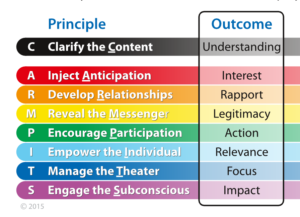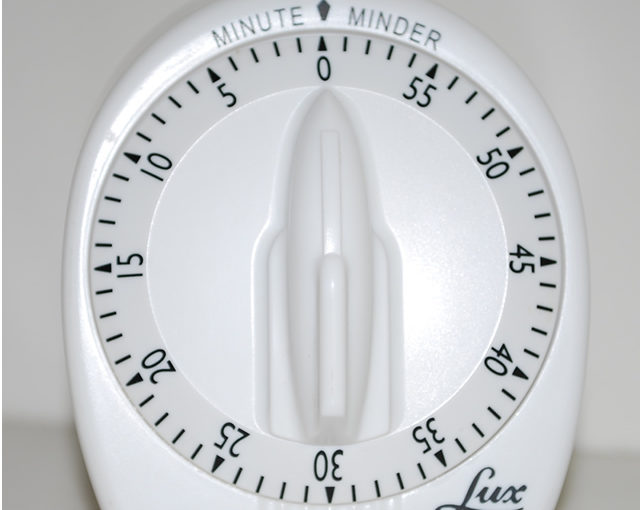Have you heard that you have just 30 seconds to get the listener’s attention when you start a presentation? That’s not exactly true. There is a time that’s even more important.
Have you ever wondered why people aren’t participating, aren’t asking questions, or seem disconnected? Why don’t they respect you, or trust you, or laugh at your jokes? Do they act like they don’t care?
If you listen to traditional public speaking training you’ll be told the first 30 seconds make all the difference.
The first 30 seconds of public speaking
It’s not about the first 30 seconds.
I’ve always been great at the first 30 seconds. In fact, in some circles I developed somewhat of a reputation for opening my classes and speeches with a bang! But when it comes to great presentation skills, opening with a bang is not enough.
Years ago a woman hired me to teach retirement seminars. She told me to open with a shocking statistic. I tried it.
90 percent of Americans don’t have enough money to retire!”
It didn’t work. At least it didn’t do what I wanted:
Why did I have such a hard time getting participation?
Why didn’t people laugh at my jokes?
Why did the audience seem disconnected?
My boss may have thought her fact was a “shocking” statistic, but I didn’t. Do you? Results don’t come from what you say, results come from how it’s perceived.
For example, is $49 a lot of money?
I know your answer:
It depends.
Is your opener shocking? It depends.
Is your joke funny? It depends.
Does the audience care? It depends.
Are they willing to ask questions? It depends.
Do they trust and respect you? It depends.
No matter what you say, the listener can only understand it in relation to something else. This is called priming. $49 is a lot for a candy bar, but not for a BMW.
Great presentation skills, great communication, and great public speaking requires great priming.
Implement the most important presentation skills before you begin
 For years, I made the mistake of starting my presentations with a bang without first priming the audience.
For years, I made the mistake of starting my presentations with a bang without first priming the audience.
If they’re not laughing it’s because you didn’t prime them to laugh. If they’re not participating it’s because you didn’t prime them to participate.
The best time to do that is not in the first 30 seconds. They best time to prime the audience for the outcome you want is before the first 30 seconds.
The 2 minutes before you officially begin your presentation will change everything.
When I first began teaching all-day, 8 hour seminars I did what I was told. I began with a supposedly “shocking” or energetic attention-grabbing opener. In spite of a great opener, the rest of the 8 hour days were torture. Little participation, few questions, and no laughs.
After implementing just one 2 minute dialog “before I began,” people started joking around, laughing at my jokes, and participating in the group.
All you have to do is prime the listener for the outcome you desire.
Step 1 Choose an outcome
Take a look at the 7 colored SpeechDeck principles and decide which one will best help you achieve your goal.

For example, if you want more questions, more discussion, and more action and compliance, choose the green “Encourage participation” principle.
If you feel you are having trouble earning respect or legitimacy, choose “Reveal the Messenger” yellow.
One of the most common problems is developing rapport with an audience of strangers. This is why politicians and salespeople often start with orange “Develop Relationships” techniques.
Step 2 Prime the audience
The very first words out of your mouth will set the precedent (prime) against which the next 8 minutes or 8 hours are interpreted.
The reason I failed to get more participation when I was a new instructor was because I started by performing a well rehearsed dramatic bang.
 Unknowingly, since I was “performing” an introduction, I was priming the audience to expect a scripted performance from me. Naturally then, they didn’t participate in later class discussions. You wouldn’t interrupt a stage performer with a question, would you? Because the first words out of my mouth were performed, every question I asked all day was interpreted as it would be in a performance–as a rhetorical question.
Unknowingly, since I was “performing” an introduction, I was priming the audience to expect a scripted performance from me. Naturally then, they didn’t participate in later class discussions. You wouldn’t interrupt a stage performer with a question, would you? Because the first words out of my mouth were performed, every question I asked all day was interpreted as it would be in a performance–as a rhetorical question.
When I began a class with a “shocking” quote. Every joke I told for the next 8 hours was interpreted through the lens of “shocking” instead of “funny.”
When I primed the audience with a statistic I setup the perception of a lecture. Goodbye rapport!
To setup the correct prime, tell the audience that you haven’t started yet.
Before we begin I would just like to …
Based on the colored principle chosen in step 1 choose any SpeechDeck technique of a matching color to set the precedent for how you want them to react later on. Whatever outcome you want, set the precedent (prime) for that outcome from your very first words.
If you want them to laugh all day, you better start with something funny. If you want them to participate in discussion all day, you better start by letting them talk. If you want a relaxed non-lecture atmosphere, you better start with a non-lecture conversation.
I added just 2 minutes to my all-day seminars that changed everything. I wanted more participation, so I started with a prime for participation:
Before we begin, raise your hand and tell the group what you hope to gain from today’s workshop.
For the first 2 minutes “before we began” we had a short conversation with each other. Overnight, my workshops transformed from lectures into discussions with so much audience participation that I had to stop accepting questions. They started relaxing, laughing at my jokes, taking me less seriously, chiming in with their own opinions, and respecting me as a real person.
Why? Because I changed the prime.
The rest of my public speaking skills didn’t change, but changing the prime changed everything.
Step 3 Begin Again
After the prime is set, simply tell the group that it’s time to begin.
Now to begin ….
 Since you never officially began your presentation, you can start over. The second you officially “begin,” the audience is now obligated to start listening … again.
Since you never officially began your presentation, you can start over. The second you officially “begin,” the audience is now obligated to start listening … again.
This is the 30 seconds when you can grab their attention with drama, shock, humor, or intrigue. But this time since it’s not the first thing they hear, it will not set a misdirected prime. Your introduction will serve only the right purpose, getting attention.
By having a conversation (or other priming experience) “before you begin” and “beginning” officially later, you get to cheat. You get to begin twice!
This double beginning is possible in almost every setting that is not a “performance.”
Use the first beginning to set the prime. Use the second beginning to grab attention.
You actually do get a second chance to make a first impression. They won’t know why, but they’ll love you.

